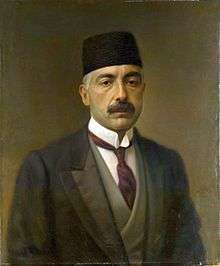Vossug ed Dowleh
Hassan Vossug ed Dowleh[2][3][4] (Persian: حسن وثوقالدوله; 1 April 1868 – 3 February 1951) was Prime Minister of Qajar-era Iran. He served as Prime Minister of Iran twice.
Vosough od-Dowleh | |
|---|---|
وثوقالدوله | |
 Vosough od-Dowleh by Kamal-ol-molk, painted between 1900 and 1917 | |
| 16th Prime Minister of Iran | |
| In office 29 August 1916 – 5 June 1917 | |
| Monarch | Ahmad Shah Qajar |
| Preceded by | Sepahsalar-e Tonekaboni |
| Succeeded by | Mohammad-Ali Ala al-Saltaneh |
| In office 8 August 1918 – 3 July 1920 | |
| Monarch | Ahmad Shah Qajar |
| Preceded by | Najaf-Qoli Samsam al-Saltaneh |
| Succeeded by | Hassan Pirnia |
| Personal details | |
| Born | 1 April 1868 Tehran, Iran |
| Died | 3 February 1951 (aged 82) Tehran, Iran |
| Political party | Democrat Party[1] |
He was the older brother of Ahmad Qavam.
Life
Hassan Vosough was born to one of Iran's most famous families. His father was named Mirza Ebrahim Motamed os-Saltaneh, and his grandfather was named Mohammad Qavam od-Dowleh. His ancestors had already served at high ranks under the Shah of Iran. Four members of his family were prime ministers: Ahmad Qavam, Mostowfi ol-Mamalek, Ahmad Matin-Daftari, and Mohammad Mosaddegh.
His mother died when he was at an early age, making his uncle take care of. His father worked as a financial manager in several provinces of Iran. Hassan received a good education through home teachers and spoke fluent French and English. As an adolescent, he accompanied his father on his travels, and took over the financial administration of Iranian Azerbaijan at a young age.
Vosough was elected in part as a founding member of the inaugural session of the first parliament of Iran in 1906 as deputy president of the Parliament. In the years of 1911–1915, Vosough was the first foreign minister and later finance minister of Iran. He later became prime minister from August 1916 to June 1917. After the abdication of the Russian Tsar on 15 March 1917, hope came to Iran for an end of World War I, and withdrawal of Russian and British troops who invaded Iran in November 1914, and were occupying the country since that time.
Vosough played a leading role in the negotiations with the British Ambassador, which resulted in the Anglo-Persian Agreement that would end badly for the Iranians. Later it became known that Great Britain had bribed Vosough for this agreement. Although Vosough denied that he had enriched himself personally, and also offered to repay the money.[5] His reputation was so damaged that he left Iran. He returned in 1926 to refund a portion of the bribe back to Iran.
During the reign of the new king of Iran, Reza Shah, Vosough returned to the country in June 1926, where he became the financial officer, and later became minister of Justice. In November 1926 he resigned as minister because he had applied for a seat in the Iranian Parliament and was also elected. After the expiry of the seventh session of the Iranian parliament in 1928, Vosough withdrew from politics. He was still frequently consulted by Reza Shah in financial matters. In 1936 he became a member of the newly founded Academy of Persian Language and Literature.
Hassam Vosough died in 1951 in Tehran.
See also
- Qajar Dynasty
- List of Prime Ministers of Iran
References
- Katouzian, Homa (2006). State and Society in Iran: The Eclipse of the Qajars and the Emergence of the Pahlavis. Library of modern Middle East studies. 28. I.B.Tauris. p. 90. ISBN 1845112725.
- British Miscalculations: The Rise of Muslim Nationalism, 1918-1925
- ranian-American Diplomacy
- The New Anglo-Persian Agreement
- Cyrus Ghani: Iran and the rise of Reza Shah. I.B.Tauris, 2000, p. 54.
Sources
- 'Alí Rizā Awsatí (عليرضا اوسطى), Iran in the Past Three Centuries (Irān dar Se Qarn-e Goz̲ashteh - ايران در سه قرن گذشته), Volumes 1 and 2 (Paktāb Publishing - انتشارات پاکتاب, Tehran, Iran, 2003). ISBN 964-93406-6-1 (Vol. 1), ISBN 964-93406-5-3 (Vol. 2).
| Political offices | ||
|---|---|---|
| Preceded by Mohammad Vali Khan Tonekaboni |
Prime Minister of Iran 1916–1917 |
Succeeded by Mohammad-Ali Ala al-Saltaneh |
| Preceded by Najaf-Qoli Samsam al-Saltaneh |
Prime Minister of Iran 1918–1920 |
Succeeded by Hassan Pirnia |